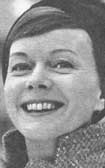Anita Björk
Anita Björk (25 April 1923 – 24 October 2012) was a Swedish actress.[1]
Anita Björk | |
|---|---|
 Anita Björk, early 1960s | |
| Born | Anita Barbro Kristina Björk 25 April 1923 Tällberg, Sweden |
| Died | 24 October 2012 (aged 89) Stockholm, Sweden |
| Occupation | Actress |
| Years active | 1942–2000 |
| Spouse(s) | |
| Children | Jonas Bergström |
She was born in Tällberg, Dalarna and attended Dramatens elevskola (The Royal Dramatic Theatre's acting school) from 1942 to 1945. She was a leading lady of Swedish theatre for many years and worked on the national stage Dramaten from 1945 onwards and played more than 100 roles over the years (which makes her one of the greatest actors of Dramaten).
Anita Björk played leading roles in film in a number of genres, including thrillers and crime mystery dramas such as Det kom en gäst (1947), Moln över Hellesta (1956), Damen i svart (1958), Mannekäng i rött (1958) and Tärningen är kastad (1960). Her most famous role was probably her title role in Alf Sjöberg's film adaption of Strindberg's Miss Julie (1951) that was awarded the grand prize at Cannes Film Festival.
In the book-length interview Hitchcock/Truffaut (Simon and Schuster, 1967), Hitchcock said he had hired Björk as the female lead for I Confess in 1952 after seeing her in Miss Julie. However, when Björk arrived in Hollywood with her lover Stig Dagerman and their baby, Jack L. Warner, the head of Warner Brothers insisted that Hitchcock should find another actress.
She was married to Olof Bergström (1945–1951) and to Stig Dagerman (from 1953). After Dagerman's death in 1954, she had a relationship with author Graham Greene.
In 2009 she performed in A. R. Gurney's play Kärleksbrev (Love Letters) at Dramaten opposite Jan-Olof Strandberg (Lilla scenen; March–April, 2009).
Björk died on 24 October 2012 at the age of 89.[2]
Selected filmography
- 1942 - Himlaspelet (a.k.a. The Heavenly Play/The Road to Heaven)
- 1944 - Räkna de lyckliga stunderna blott
- 1947 - Det kom en gäst
- 1947 - Kvinna utan ansikte (a.k.a. Woman Without a Face)
- 1950 - Kvartetten som sprängdes (a.k.a. The Quartet That Split Up)
- 1951 - Fröken Julie (a.k.a. Miss Julie)
- 1952 - Kvinnors väntan (a.k.a. Secrets of Women)
- 1954 - Night People
- The Witch (1954)
- 1955 - Giftas (a.k.a. Of Love and Lust)
- 1955 - Hamlet (TV theatre)
- 1955 - The Cornet
- 1956 - Moln över Hellesta (a.k.a. Moon Over Hellesta)
- 1956 - Sången om den eldröda blomman (a.k.a. Song of the Scarlet Flower)
- 1958 - Damen i svart (a.k.a. The Lady in Black)
- 1958 - Mannekäng i rött (a.k.a. Mannequin in Red)
- 1958 - Körkarlen (a.k.a. The Phantom Carriage)
- 1960 - Tärningen är kastad
- 1961 - Square of Violence
- 1962 - Vita frun (a.k.a. The Lady in White)
- 1963 - Misantropen (TV theatre)
- 1964 - Älskande par (a.k.a. Loving Couples)
- 1969 - Ådalen 31 (a.k.a. Adalen 31/Adalen Riots)
- 1978 - Tribadernas natt (TV theatre)
- 1979 - Arven
- 1981 - The Witch Hunt
- 1986 - Amorosa
- 1989 - Flickan vid stenbänken (mini series)
- 1992 - Den goda viljan (a.k.a. Best Intentions) (script: Ingmar Bergman)
- 1992 - Markisinnan de Sade (TV theatre; Ingmar Bergman)
- 1993 - Snoken (TV series)
- 1996 - Enskilda samtal (a.k.a. Private Confessions/Conversations) (TV theatre; Ingmar Bergman)
- 1997 - Larmar och gör sig till (a.k.a. In the Presence of a Clown) (TV theatre; Ingmar Bergman)
- 2000 - Bildmakarna (a.k.a. The Image Makers) (TV theatre; Ingmar Bergman)
References
- "Décès de l'actrice Anita Björk". AlloCine. Retrieved 24 October 2012.
- https://www.telegraph.co.uk/news/obituaries/9659117/Anita-Bjork.html